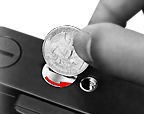The secondary mirror that interlocks behind the main reflex mirror seen only when it is in half mirror lock up position. You won't be able to see it even if you view it without a lens mounted or using mirror lock up feature. Like the electronic circuit that was protected under the robust metal die-cast structure, these are stealth technologies in the F3 camera body oblivious to the photographer.
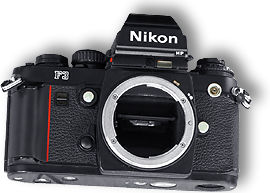 |
|
In fact, most modern cameras have more than sufficient features to provide you the tools to tackle or handle virtually any imaginable photographic situation - perhaps only separated by how knowledgeable you are toward the hardware that you own and how to it to good use in your personal photography.
Based
on experience and initial feedback after uploading other similar
featured sites, I noticed there are a great deal of surfers asking
a lot of basic questions which can be answered in a camera manual.
It is all about perspective from the camera manufacturer's point of
view or from a view point of a consumer. A well illustrated and
simple to understand manual is very much depend on an individual's
level of experience in handling a SLR camera. Even for a P&S user,
I think some areas in instruction manuals can be very
confusing for the starter in SLR photography. Sections like depth of
field or shutter speed are generally very well illustrated in a manual
- BUT combined, all these number could confuse a novice.
Further, sometimes you need to explain to someone new to this medium
why his zoom lens cannot shoot as close as those great magnification
macro pictures that illustrate magazines or calendars. You just cannot
please everybody in a general site. But since this essential info may
benefit a new F3 user or for those who have lost, misplaced or don't
understand what the content in the manual is all about, I will try to
explain here and add in some related info that may help you understand
this camera better. Don't worry, if you have bought a Nikon F3, as long
as you can digest, I will try my best to help you justify your
investment fully. If you have already owned the Nikon F3 for a long
time and are very familiar with it, just skip these pages. Please don't
mail me, if you have anything hot to debate, use the message board
instead. It is pretty easy to read, but not that easy to compile and
write. Anyway, neither are they my speciality, but despite that I am
still trying to enjoy what I am doing until the very one day I feel
tired of all these. Enjoy.
Basic Camera Operations:
Nikon F3 is an automatic camera. It uses battery to power most of its functions like
metering, shutter operation etc. In short, without battery (ies) installed in the
camera, you can take pictures with only two mechanical settings that do not
require battery to operate, but with the power supply restored, it will be fully operational
with all the automated features that are incorporate and designed into the camera body.
 |
|
|
|
2. Install the batteries.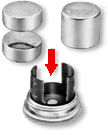 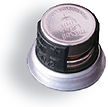 |
|
A fresh installation
can last for about a year, depends on usage. The shutter locks at battery depletion,
unlock by turning the shutter speed dial to M250 or B setting, which are mechanical
and works independent of battery power.
Note: Insert the two 1.55V
silver-oxide batteries or one 3V lithium battery supplied with the camera, making
sure that the "+" signs are up. Under normal usage in room temperature,
one set of l.55 V silver-oxide batteries (Eveready EPX76 or equivalent) will last
for about one year.
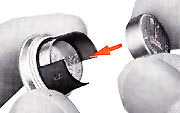 |
|
Make sure the battery contacts (+ or - surfaces) are clean. As most problems that arise with automatic cameras are battery related. Sometimes, even an invisible film can prevent proper contact like your sebum or oily finger tips. Generally, as a guideline in normal camera maintenance & care, never hold any cells in the centrer, only at the side. You may use either a clean cloth to clean off a light layer of oxidation, and a pencil eraser from your children's pencil box will remove heavier deposits that may deposited at the cells' polarity marks front and back or the contact point (battery clip) inside the camera battery compartment.
Don't let
this scare you off.
The Nikon F3, as with any of the automatic manual focus Nikon bodies like the earlier
EL bodies, FE series models or the FA - they have accessories to assure
your camera can perform equally well under extreme temperatures. The Nikon F3 in
particular, being a professional camera, has a few options available. Just in
case you are in an important assignment, for a preventive measure, there are a few
ways to buy some insurance. The Anti-Cold Battery Pack DB-2 is one such
device. In cold weather, the Anti-Cold Battery Pack DB-2, which accepts two
AA-type batteries, acts as an alternative power supply to the batteries inside the
camera body. Simply connect the DB-2 to the camera body, then slip the assembly inside
your pocket or coat to keep it warm. This assures that the camera's metering system
will function even in very cold temperatures. Next option is even better - Nikon
F3's power supply will automatically switches over and supply by its dedicated Motor
Drive MD-4. With the motor drive, again you have a few options in the types
of battery cells, depends on your priorities, for most cost efficient shooting, you
can use the normal alkaline which can easily help you sail through 100 rolls of 36
exposures film rolls. For cold weather, you can opt for the rechargeable Ni-Cd
cells (MN-2). well, there are more to offer for a motor drive than just the power
supply issues, we will discuss that in later in the automatic film advance section.
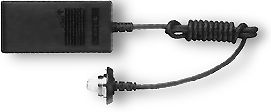 |
|
| Anti cold Battery Pack DB-2 | Rechargeable Ni-Cd cells for motor drive MD-4 |
3. Replace the battery chamber lid. Slip the battery clip back into the camera body and screw it tightly into place. |
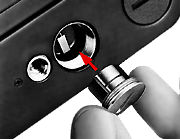 |
Some other issues relate to batteries
|
1. |
When the batteries are drained, or there are none installed in the camera, or if it fails to function normally due to extreme change in temperature, the F3 has only two settings which still can be used : a mechanical speed of approx. 1/55 sec via backup mechanical release lever(Check the main reference map) and “T” (Time exposure setting on your shutter speed dial). All other speed settings will be inoperative, and the shutter won't fire or the reflex mirror MAY remain in the “up” position. If the mirror locks up, simply trip the camera via the mechanical speed lever again and the mirror will return to its normal viewing position. Then you can install new batteries (In the case of cold climate, use an anti-cold battery holder pack DB-2 to replace the cells or attach the F3 to the MD-4 with Ni-Cd cells). For important assignments,it is a good idea to carry an extra set of batteries with you or look at the few very good alternatives Nikon provides for the F3 users.. |
|
2 |
Should the battery be left in the battery chamber for a long period, insufficient contact may occur due to battery leakage. Thus, it is good practise to periodically clean the battery and the contact section in the battery chamber with a soft cloth. If the battery chamber is contaminated with a leaking battery, remove the battery at once and clean the chamber. Before doing so, try to clean and remove any deposits remaining inside, especially the clips housed inside the compartment and do a few test shots, but I would strongly suggest you get an examination of the damage done. |
|
3 |
For safety reasons at home, after removal of the cells, remember to keep them away from children. Never attempt to throw them in a fire place, it may explode. In any case, the camera is not the cause for any mishap - only the carelessness of its owner. |
|
4 |
Battery power falls off in extremely cold temperatures and this may cause the camera's photometric circuit to cease operating. In this situation, use new batteries and protect the camera body from the cold. Note that battery power will be recovered as soon as the temperature becomes normal. Nikon has an anti-cold battery holder pack DB-2 for this purpose, alternatively, use the F3 with the MD-4, which will overwrite the battery cell in the camera body (You need not have to remove the cell when attach the MD-4). With the motor drive attached, the camera gets all its power from the batteries in the motor drive. Thus, if you use a NiCd battery, the camera/motor drive will operate down to - 20°C. |
|
5 |
Regardless of whether the camera is switched off or not, the Nikon F3 always discharges a small amount of electricity because it incorporates a quartz oscillator circuit. Further, at -10°C or below, the LCD may exhibit a slight delay in 'response time. This is natural and should not be a cause for concern. However, exposure of the camera to extremely high temperatures (80°C and above) may actually shorten the life span of the LCD (liquid Crystal Display). |
|
| | | Back to Index of Nikon F3 Models Back to Pictorial History of Nikon SLRs |
|
|||||
|
|||||||
| Back |
Index Page of F3 Camera Manual |
Back | Main Index
Page of Nikon
F3 models
| About this photographic site | Contributions and Credits |
 |
Home - Photography in Malaysia |
